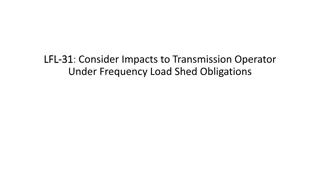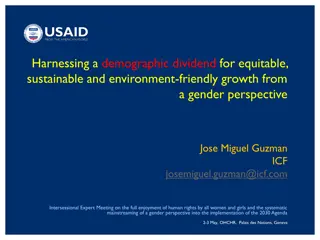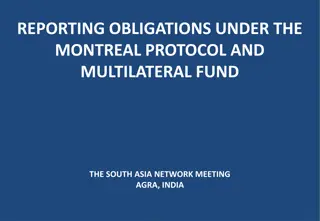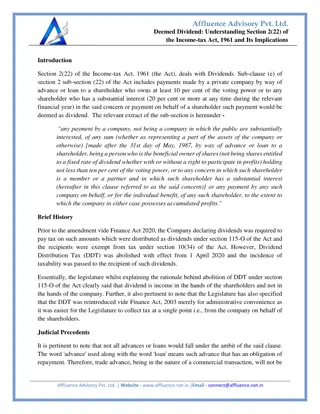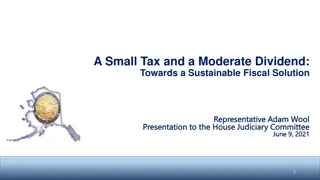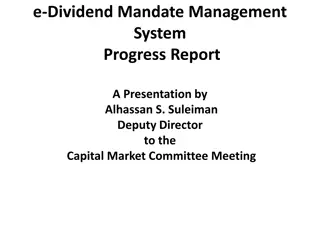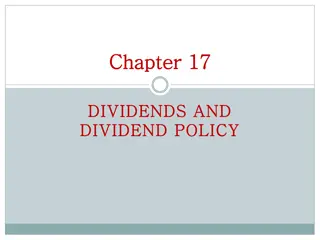Overview of Multilateral Frequency Coordination Meeting for Digital Dividend Implementation
The Multilateral Frequency Coordination Meeting discussed progress in implementing digital switchover and digital dividend in the GE06 countries. It highlighted the allocation of spectrum for mobile services and the importance of coordinated implementation. Various coordination groups in Region 1 work towards shaping UHF band utilization and facilitating changes in the GE06 Plan through coordinated requirements. The meeting aimed to enhance consensus, search for additional TV channels, and streamline coordination efforts for optimal spectrum usage.
Download Presentation

Please find below an Image/Link to download the presentation.
The content on the website is provided AS IS for your information and personal use only. It may not be sold, licensed, or shared on other websites without obtaining consent from the author.If you encounter any issues during the download, it is possible that the publisher has removed the file from their server.
You are allowed to download the files provided on this website for personal or commercial use, subject to the condition that they are used lawfully. All files are the property of their respective owners.
The content on the website is provided AS IS for your information and personal use only. It may not be sold, licensed, or shared on other websites without obtaining consent from the author.
E N D
Presentation Transcript
Multilateral Frequency Coordination Meeting of Caspian and Central Asia administrations on the UHF band 30 31 March, 2017 Overview of the DSO and Digital Dividend implementation in the GE06 countries Nikolai Vassiliev Chief, BR Terrestrial Services Department International Telecommunication Union
GE06 Digital Switchover Status of Digital Switchover in the GE06 planning area: COMPLETED : 46 ON-GOING: 56 NOT STARTED: 10 Source: ITU DSO database at http://www.itu.int/en/ITU-D/Spectrum- Broadcasting/Pages/DSO/dashboard.aspx Transition to digital television liberates a portion of spectrum, Digital Dividend (DD), which may be used for new TV services or other applications, e.g. mobile service
Digital Dividend WRC-07 allocated 790 862 MHz to mobile service in R1 (DD1) WRC-12 allocated 694 790 to mobile service in R1 (DD2) RR give flexibility: allocations to broadcasting and mobile services Choice of the service is a national decision. But international aspects are critical, taking into account: Difficulties in sharing between broadcasting and mobile in border areas Advantages of global harmonization of IMT bands below 1 GHz Coordinated implementation of DD is very important -> a number of R1 countries created groups dealing with re-arrangement of the 700 MHz and 800 MHz bands and implementation of DD E.g. WEDDIF West European Digital Dividend Implementation Forum
Region 1 coordination meetings and groups WEDDIF: 8 countries, created in 2010 NEDDIF: 12 countries, created in 2010 SEDDIF: 11 countries, created in 2014 BSDDIF (Black Sea): 4 countries so far, created 2016 Sub-Sahara Africa coordination meetings: 47 countries, 2011 - 2014 ASMG coordination meetings: 28 countries, 2014 - 2015 Meeting of Black and Caspian sea countries: 7 countries, 2013
Region 1 UHF activities More than 100 countries of the GE06 Area participate in UHF coordination
Objectives of coordination groups To build informal consensus on UHF band utilization, aimed at concluding formal agreements To search additional TV channels below 694 MHz and to facilitate their coordination, in the event 700/800 MHz allocated to IMT To facilitate modification of the GE06 Plan through the Article 4 procedure by submitting coordinated requirements
Working methods Meetings 2 4 times per year, 3 5 days Review of activities and resolving problems Submission of requirements and compatibility analysis Bi- and multilateral coordination, refining technical parameters Bi-lateral coordination between the meetings by correspondence
Technical aspects Agreed number of layers (multiplexers) The same minimum number of MUX for each administration (4 in the Sub- Sahara Africa and Arab groups); or Chosen by each country (CEPT). When different, balanced by quality of layers, e.g. if less MUXs -> more protection, higher emissions (WEDDIF) Assignments vs allotments Planning for both, with preference for assignment planning Allotments are simplified compared with GE06, describing service area Coordination of assignments within allotments, SFNs Coordination criteria (Field strength, C/I, coordination margin) Relaxed compared with GE06 (e.g., due to reduced % of locations) The same criteria for Group (e.g. coord. margin = 4 dB) or agreed bilaterally Freezing GE06 until coordination is completed
Lessons learned Exchange of files and creating database is critically important Files contain channels in 470 694 MHz, and in 700/800 MHz Channels in use, licensed channels and future requirements Database of agreed channels to fix the situation, kept by a focal point Roadmap is useful Defines steps, deadlines for completion of activities Liaison with other groups is necessary, due to the domino effect of planning Mapping channels (placing on maps) is illustrative
Incompatibility table Example HRV AUT NOS BIH PLJ STO KO S++ TO NOO LEO MAJ VEL BN OON TRO NON KOZ STW KW BJE BS NOW OOS STM TUS VLA HRV-D01 26 HRV-D02 23, 26, 30, 39 26 HRV-D02-east 38 HRV-D02-west HRV-D03 28 34 HRV-D04 28 48 *41 HRV-D05 28, 39, 46 34 HRV-D06 30, 46 30, 31 34 31 HRV-D07 31 HRV-D08 34 33 HRV-D09 28 34 incompatible partly incompatible * not compatibile with our local coverage which is in operation (L-ZA - Sveta Nedelja)
UHF assigned channels-GE06 Plan UHF assigned channels-GE06 Plan 90.00% 80.00% 70.00% 60.00% 50.00% 40.00% 30.00% 20.00% 10.00% 0.00% ARM AZE GEO IRN KAZ KGZ RUS TJK TUR TKM UZB 470-694 694-790 790-862
Region 1 UHF activities More than 100 countries of the GE06 Area participate in UHF coordination. Can some color be added to the white space ?
Thank you for your attention!






